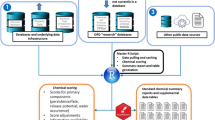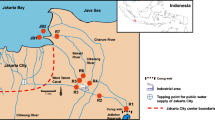Abstract
A toxicity identification evaluation (TIE) was performed on a municipal effluent, and three toxicants were identified, ammonia, chlorine, and diazinon. Ammonia and chlorine were the only toxicants present at toxic concentrations in all sample sets, and diazinon was present in toxic concentrations in one of the effluent sample sets. Six effluent sets taken over an 8-month period were evaluated in this TIE. The nonpolar toxicity, primarily due to diazinon, was intermittent since it was present at toxic concentrations only once in the 8-month time period.
This report illustrates the types of data and logic used in performing a TIE which contains common municipal toxicants. Emphasis in this report was place on the data needed for generating the “weight of evidence” in toxicant confirmation, Phase III, to support the suspect toxicants identified in the TIE process. Multiple Phase III manipulations, when applied to numerous effluent samples, provided consistent results for generating the “weight of evidence” for the confirmation of ammonia and chlorine as the primary causes of toxicity in this effluent.
Similar content being viewed by others
References
Amato JR, Mount DI, Durhan EJ, Lukasewycz MT, Ankley GT, Robert ED (1992) An example of the identification of diazinon as a primary toxicant in an effluent. Environ Toxicol Chem 11:209–216
Ankley GT, Burkhard LP (1992) Identification of surfactants as toxicants in primary effluents. Environ Toxicol Chem 11:1235–1248
Ankley GT, Katko A, Arthur JW (1990) Identification of ammonia as an important sediment-associated toxicant in the lower Fox River and Green Bay, Wisconsin. Environ Toxicol Chem 9:313–322
Ankley GT, Phipps GL, Leonard EN, Benoit DA, Mattson VR, Kosian PA, Cotter AM, Dierkes JR, Hansen DJ, Mahony JD (1991) Acid volatile sulfide as a factor mediating cadmium and nickel bioavailability in contaminated sediments. Environ Toxicol Chem 10:1299–1307
Burkhard LP, Ankley GT (1989) Identifying toxicants: NETAC's toxicity-based approach. Environ Sci Technol 23:1438–1443
Burkhard LP, Durhan EJ, Lukasewycz MT (1991) Identification of nonpolar toxicants in effluents using toxicity-based fractionation with gas chromatography/mass spectrometry. Anal Chem 63:277–283
Doi J, Grothe DR (1987) Use of fractionation/chemical analysis schemes for plant effluent toxicity evaluations. In Suter GW II, Lewis MA (eds) Aquatic toxicology and environmental fate, ASTM STP 1007. ASTM, Philadelphia, Vol 11, pp 123–138
Durhan EJ, Norberg-King TJ, Burkhard LP (1993) Methods for aquatic toxicity identification evaluations: Phase II toxicity identification procedures for samples exhibiting acute and chronic toxicity. EPA/600/R-92/080. USEPA, Environmental Research Laboratory, Duluth, MN
Hamilton MA, Russo RC, Thurston RV (1977) Trimmed Spearman-Karber method for estimating median lethal concentrations in toxicity bioassays. Environ Sci Technol 11:714–719; Correction: (1978) 12:417
Higashi RM, Cherr GN, Shenker JM, Macdonald JM, Crosby DG (1992) A polar high molecular mass constituent of bleached kraft mill effluent is toxic to marine organisms. Environ Sci Technol 26:2413–2420
Jarvinen AW, Tanner DK (1982) Toxicity of controlled release and corresponding unformulated technical grade pesticides to the fathead minnow (Pimephales promelas). Environ Pollut (Ser A) 27:179–195
Jop KM, Kendall TZ, Askew AM, Foster RB (1991) Use of fractionation procedures and extensive chemical analysis for toxicity identification of a chemical plant effluent. Environ Toxicol Chem 10:981–990
Kszos LA, Stewart AJ, Taylor PA (1992) An evaluation of nickel toxicity to Ceriodaphnia dubia and Daphnia Magna in contaminated stream and in laboratory tests. Environ Toxicol Chem 11:1001–1012
Kuehl DW, Ankley GT, Burkhard LP, Jensen D (1990) Bioassay directed characterization of the acute aquatic toxicity of a creosote leachate. Hazardous Waste Hazardous Mater 7:283–291
Mount DI (1989) Methods for aquatic toxicity identification evaluations: Phase III toxicity confirmation procedures. EPA 600/3–88–036. USEPA, Environmental Research Laboratory, Duluth, MN
Mount DI, Anderson-Carnahan L (1988) Methods for aquatic toxicity identification evaluations: Phase I toxicity characterization procedures. USEPA, EPA-600/3–88–034. Environmental Research Laboratory, Duluth, MN
—, — (1989) Methods for aquatic toxicity identification Phase II toxicity identification procedures. USEPA, EPA-600/3–88–035. Environmental Research Laboratory, Duluth, MN
Mount DI, Norberg-King TJ (1993) Methods for aquatic toxicity identification evaluations: Phase III toxicity confirmation procedures for samples exhibiting acute and chronic toxicity. EPA/600/R-92/081. USEPA, Environmental Research Laboratory, Duluth, MN
Norberg-King TJ, Durhan EJ, Ankley GT, Robert E (1991a) Application of toxicity identification evaluation procedures to the ambient waters of the Colusa Basin Drain, California. Environ Toxicol Chem 10:891–900
Norberg-King TJ, Mount DI, Durhan EJ, Ankley GT, Burkhard LP, Amato JR, Lukasewycz MT, Schubauer-Berigan MK, Anderson-Carnahan L (1991b) Methods for aquatic toxicity identification evaluations: Phase I toxicity identification evaluations, 2nd ed. EPA-600/6–91/003. USEPA, Environmental Research Laboratory, Duluth, MN
Norberg-King TJ, Mount DI, Amato JR, Jensen DA, Thompson JA (1992) Toxicity identification evaluation: Characterization of chronically toxic effluents, Phase I. EPA/600/6–91/005F. USEPA, Environmental Research Laboratory, Duluth, MN
Schubauer-Berigan MK, Ankley GT (1991) The contribution of ammonia, metals and nonpolar organic compounds to the toxicity of sediment interstitial water from an Illinois River tributary. Environ Toxicol Chem 10:925–939
US Environmental Protection Agency (1989) Short-term methods for estimating the chronic toxicity of effluents and receiving waters to freshwater organisms. EPA-600/4–89/001. USEPA, Environmental Monitoring and Support Laboratory, Cincinnati, OH
— (1985) Ambient Water Quality Criteria USEPA, Environmental Research Laboratory-Duluth, Duluth, MN, and the Criteria and Standards Division, Washington, DC
— (1991) Technical Support Document for Toxics Control. EPA/505/2–90–001. USEPA, Office of Water, Washington, DC
Author information
Authors and Affiliations
Rights and permissions
About this article
Cite this article
Burkhard, L.P., Jenson, J.J. Identification of ammonia, chlorine, and diazinon as toxicants in a municipal effluent. Arch. Environ. Contam. Toxicol. 25, 506–515 (1993). https://doi.org/10.1007/BF00214340
Received:
Revised:
Issue Date:
DOI: https://doi.org/10.1007/BF00214340




